Client Brief
The brief for the project was to cater to individuals and families seeking upscale accommodations. The client came to Opus Architects looking to create a space for high-end serviced apartments that offer a unique experience for the guests. The emphasis was on creating spaces that are bespoke and distinct from those currently offered in the market, with a focus on unique design features and amenities that set the building apart from its competitors. The apartments were to be designed with a focus on comfort and luxury, providing all the amenities in compact spaces. Additionally, the client requested the inclusion of a café space as well as a co-working space in the building, thereby providing them with the option to dine and work in-house.
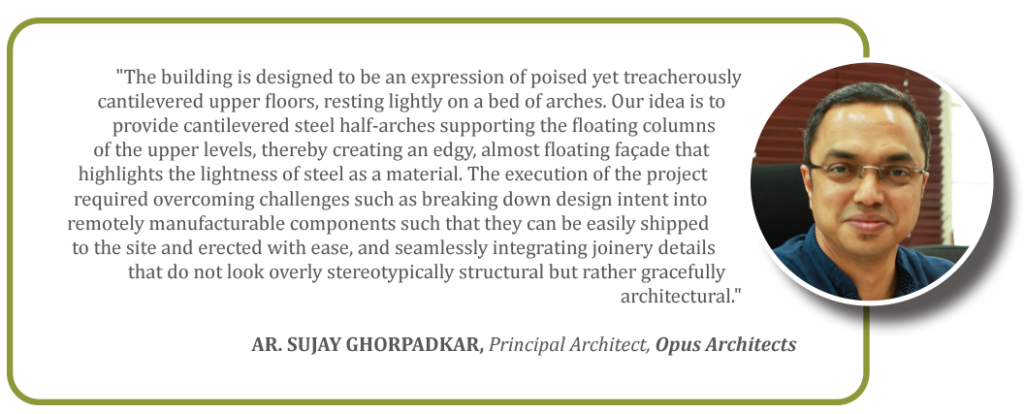
Initial Thought
Upon closely studying and analysing the client’s requirements, we shifted our gears to brainstorming mode. The design process, being an iterative one, took shape with constant collaboration between our team and the client. The idea of bringing the industrial, exposed, uncladded aesthetic of steel was hence explored and found to be the right fit for this project. This design language was carried throughout the building using exposed clay blocks, and concrete floors along with a steel structure.
In an attempt to deviate from the norm of using steel in an ordinary manner, we decided to give the material a retro touch, reminiscent of the Victorian era to some extent. Since similar design attributes are observed in London, we turned to the infamous train stations that had caught our eye during a visit. These Victorian architectural wonders, with their cathedral-like volumes, clustered columns, arches, sense of symmetry, and overall harmony, influenced the creation of steel half-arches throughout our façade. Our primary goal was to make this an integral part of the design in a more contemporary format.
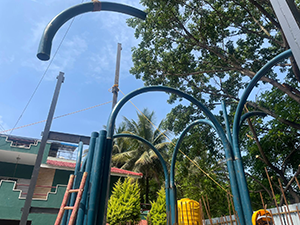
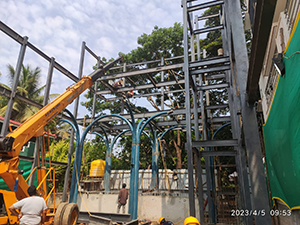
Choice of Material
The introduction and decision to use steel were essential to the design process. By using steel, we could reduce the overall structural footprint of the building, which extended our design flexibility for the rest of the building thus bringing a sense of lightness to the spaces. The unique nature of the material fits perfectly with the client’s requirement to make the building stand out from the crowd. The distinction in form was bought together by the use of steel, for its flexibility and malleability as a material, thus facilitating the unconventional use of arches as structural elements. The same attempt with concrete would have rendered the structure extremely heavy.
Design Language
The architectural design of the building emphasizes the cantilevered upper floors which are delicately balanced on a base of arches. The design concept incorporates cantilevered steel half-arches to support the floating columns of the upper levels, creating a visually striking and contemporary façade. The cantilevered structure is intended to convey a sense of balance while maintaining the necessary structural integrity to ensure the stability of the building.
Architectural Feature
The architectural features of the building showcase a blend of Victorian style with modern elements. The use of Victorian-style arches and railings adds a touch of classic elegance to the structure. Additionally, the large glass windows allow natural light to flood the space, creating a bright and open atmosphere. The concrete floors give a sense of industrialism, while the drama that unfolds owing to the four split levels and interlocking volumes invites spaciousness on a modest floor plan. The building’s design aims to see things as they are, without any embellishments or coverings, highlighting the beauty of the raw materials used. The structure’s minimalist approach is accentuated by the use of plaster, achieving a seamless finish. Overall, the building’s architectural features combine to create a unique and modern aesthetic that is both functional and pleasing.
Software Used
While AutoCAD was used for the 2D drafting, Sketchup was used for the 3D aspects required for the project. FEA and STAAD were used for structural analysis.
Overall Experience
The project presented a unique and exciting challenge, with out-of-the-box requirements that pushed the team to create a new language and structural design. As the master builders of the project, our process involved creating details from scratch, as there were no standard specifications for the joinery details. The execution of the project required overcoming challenges such as bending steel into arches, creating column clusters, breaking down design intent into remotely manufacturable components such that they can be easily shipped to the site and erected with ease, and seamlessly integrating joinery details. It took three months to design the structure and a year to execute the project.




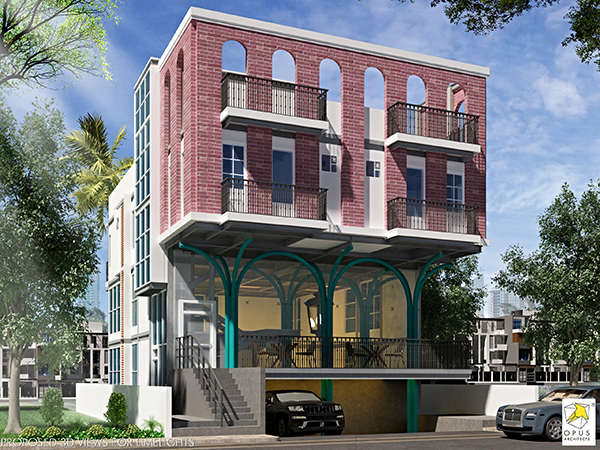

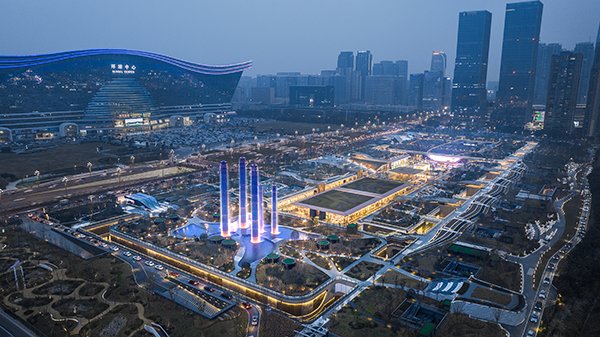
Hey there! Do you know if they make any plugins to help with Search Engine Optimization? I’m trying to get my blog to rank for some targeted keywords but I’m not seeing very good results. If you know of any please share. Many thanks!
There is noticeably a bundle to know about this. I assume you made certain nice points in features also.
After study a number of of the weblog posts in your web site now, and I actually like your manner of blogging. I bookmarked it to my bookmark web site list and will likely be checking back soon. Pls check out my web site as well and let me know what you think.
Youre so cool! I dont suppose Ive read something like this before. So nice to find any individual with some authentic thoughts on this subject. realy thanks for beginning this up. this website is one thing that is wanted on the web, someone with a little originality. useful job for bringing one thing new to the internet!
Very interesting details you have noted, regards for putting up. “It’s the soul’s duty to be loyal to its own desires. It must abandon itself to its master passion.” by Rebecca West.
naturally like your web-site but you need to check the spelling on several of your posts. Many of them are rife with spelling problems and I find it very troublesome to tell the truth nevertheless I’ll surely come back again.
You are my inspiration , I own few web logs and occasionally run out from to brand.
I like this weblog very much, Its a really nice post to read and find info .
I’ve read some just right stuff here. Definitely value bookmarking for revisiting. I surprise how much effort you set to make such a fantastic informative website.
There is noticeably a lot to realize about this. I assume you made certain good points in features also.
https://semaglupharm.com/# Semaglu Pharm
http://semaglupharm.com/# alcohol and rybelsus
LipiPharm: Online statin drugs no doctor visit – LipiPharm
CrestorPharm п»їBuy Crestor without prescription does crestor cause hair loss in women
https://semaglupharm.shop/# Semaglu Pharm
prednisone without rx: 20 mg prednisone – PredniPharm
atorvastatin and constipation Lipi Pharm Lipi Pharm
Order rosuvastatin online legally: crestor indications – rosuvastatin 5 mg tablet image
https://prednipharm.com/# Predni Pharm
http://semaglupharm.com/# Semaglu Pharm
Buy cholesterol medicine online cheap: can crestor be split in half – Crestor Pharm
Semaglu Pharm hims compounded semaglutide Semaglu Pharm
Order cholesterol medication online: LipiPharm – Lipi Pharm
PredniPharm: PredniPharm – buy prednisone tablets uk
https://semaglupharm.com/# SemagluPharm
SemagluPharm: Affordable Rybelsus price – SemagluPharm
https://semaglupharm.com/# is semaglutide covered by medicaid
Crestor Pharm: can rosuvastatin cause dry eyes – CrestorPharm
LipiPharm atorvastatin bivirkninger LipiPharm
https://semaglupharm.com/# Order Rybelsus discreetly
rybelsus dizziness: what is semaglutide – semaglutide before and after
Generic Lipitor fast delivery lipitor vs. crestor No RX Lipitor online
https://semaglupharm.shop/# semaglutide withdrawal
SemagluPharm: how to take rybelsus 14 mg – semaglutide burping
https://crestorpharm.com/# Crestor Pharm
Order rosuvastatin online legally: CrestorPharm – Crestor Pharm
Semaglu Pharm compounded semaglutide dosage how much weight can you lose on rybelsus 3 mg
https://semaglupharm.com/# Semaglu Pharm
Lipi Pharm: Lipi Pharm – LipiPharm
http://semaglupharm.com/# Semaglu Pharm
Semaglu Pharm rybelsus weight loss uk Semaglutide tablets without prescription
Lipi Pharm: accidentally took double dose of 80 mg atorvastatin – LipiPharm
Crestor home delivery USA: Generic Crestor for high cholesterol – CrestorPharm
http://crestorpharm.com/# No doctor visit required statins
lipitor medication LipiPharm atorvastatin manufacturers in usa
Order Rybelsus discreetly: SemagluPharm – Semaglu Pharm
prednisone 5mg price: PredniPharm – PredniPharm
https://semaglupharm.shop/# para que sirve rybelsus
Online pharmacy Rybelsus semaglutide names SemagluPharm
Lipi Pharm: Affordable Lipitor alternatives USA – lipitor reactions
http://semaglupharm.com/# Rybelsus online pharmacy reviews
SemagluPharm: п»їBuy Rybelsus online USA – Rybelsus side effects and dosage
LipiPharm Lipi Pharm pill identifier pill identifier atorvastatin 40 mg
https://crestorpharm.shop/# Crestor Pharm
Generic Crestor for high cholesterol: crestor take at night – CrestorPharm
lipitor 10mg tablet: atorvastatin or rosuvastatin – LipiPharm
rybelsus patient assistance program pdf SemagluPharm Semaglu Pharm
https://semaglupharm.com/# semaglutide & tirzepatide weight loss clinic
Crestor Pharm: Crestor Pharm – Order rosuvastatin online legally
mexico pharmacies prescription drugs: reputable mexican pharmacies online – Meds From Mexico
https://canadapharmglobal.shop/# best canadian pharmacy online
India Pharm Global: india online pharmacy – India Pharm Global
https://canadapharmglobal.shop/# canadian pharmacy ltd
Meds From Mexico: Meds From Mexico – Meds From Mexico
canadian pharmacy online reviews: Canada Pharm Global – canadian pharmacy oxycodone
https://indiapharmglobal.shop/# buy medicines online in india
ordering drugs from canada Canada Pharm Global best online canadian pharmacy
http://medsfrommexico.com/# Meds From Mexico
mexico drug stores pharmacies: mexico drug stores pharmacies – Meds From Mexico
onlinepharmaciescanada com: my canadian pharmacy review – maple leaf pharmacy in canada
http://indiapharmglobal.com/# reputable indian online pharmacy
Meds From Mexico mexican pharmaceuticals online mexican mail order pharmacies
Meds From Mexico: п»їbest mexican online pharmacies – Meds From Mexico
https://medsfrommexico.shop/# buying prescription drugs in mexico online
mexican border pharmacies shipping to usa: Meds From Mexico – Meds From Mexico
https://medsfrommexico.shop/# Meds From Mexico
Meds From Mexico: medication from mexico pharmacy – reputable mexican pharmacies online
India Pharm Global: India Pharm Global – world pharmacy india
purple pharmacy mexico price list Meds From Mexico Meds From Mexico
India Pharm Global: cheapest online pharmacy india – indian pharmacy online
https://canadapharmglobal.shop/# canadian pharmacy 1 internet online drugstore
my canadian pharmacy review: canadian pharmacy store – buy prescription drugs from canada cheap
canadian pharmacy world reviews canadian drug pharmacy canada drugs online review
canadapharmacyonline: canadian pharmacy king – online canadian pharmacy
https://canadapharmglobal.shop/# canadian pharmacy near me
India Pharm Global: buy medicines online in india – best online pharmacy india
canadian pharmacy world Canada Pharm Global online canadian pharmacy
buying prescription drugs in mexico: Meds From Mexico – Meds From Mexico
http://medsfrommexico.com/# best online pharmacies in mexico
http://canadapharmglobal.com/# thecanadianpharmacy
world pharmacy india: Online medicine home delivery – pharmacy website india
buy medicines online in india top 10 pharmacies in india top 10 pharmacies in india
farmaciad: Papa Farma – Papa Farma
https://efarmaciait.com/# foto di top brand
cerazette recensioni: EFarmaciaIt – algix 90 prezzo
Rask Apotek Rask Apotek apotek omega 3
apotek streik: klorhexidin apotek – Rask Apotek
https://efarmaciait.com/# EFarmaciaIt
https://papafarma.com/# parafarmacis
EFarmaciaIt: prezzo acido ialuronico – EFarmaciaIt
Rask Apotek stГёydempende Гёrepropper apotek Rask Apotek
lucen 40 senza ricetta: dottor max recensioni – EFarmaciaIt
http://papafarma.com/# Papa Farma
apotek intim Svenska Pharma billiga blöjor
EFarmaciaIt: locoidon prezzo in farmacia – EFarmaciaIt
Papa Farma: tadalafil 10 mg – Papa Farma
https://efarmaciait.com/# EFarmaciaIt
http://efarmaciait.com/# EFarmaciaIt
sildenafilo prospecto Papa Farma Papa Farma
https://raskapotek.shop/# Rask Apotek
farmasi espaГ±a catГЎlogo: tenerife.bio cannabis legal shop cbd – pharma tgm cbd oil 10 10 ml
Svenska Pharma: hur mycket vГ¤lling 7 mГҐnader – Svenska Pharma
Svenska Pharma apotek självtest corona Svenska Pharma
https://papafarma.shop/# celestone inyecciГіn
http://svenskapharma.com/# Svenska Pharma
plasil supposte esiste: EFarmaciaIt – lubrimil bustine
neoxerogen recensioni: pigitil 800 recensioni – farmaГЁ integratori
Svenska Pharma tandskena apotek Svenska Pharma
https://svenskapharma.com/# Svenska Pharma
mandelolje apotek: Rask Apotek – Rask Apotek
lutein apotek: Rask Apotek – Rask Apotek
http://efarmaciait.com/# slinda acne
enbärsolja apotek jod apotek Svenska Pharma
https://raskapotek.com/# Rask Apotek
EFarmaciaIt: farmacia online sicura – novadien a cosa serve
EFarmaciaIt: EFarmaciaIt – depo medrol cos’ГЁ
apotek/bandasjist har lГҐst resepten for behandling Rask Apotek Rask Apotek
https://papafarma.shop/# online pharmacy es seguro
Svenska Pharma: isopropanol apotek – Svenska Pharma
http://raskapotek.com/# syklodekstrin apotek
EFarmaciaIt: EFarmaciaIt – gentalyn fiale prezzo
medicinali online vendita enterogermina in gravidanza forum EFarmaciaIt
https://efarmaciait.shop/# bentelan per la gola
parafarmacie online: vessel fiale a cosa serve – EFarmaciaIt
Papa Farma bepanthol para la cara opiniones Papa Farma
prisma pillole: EFarmaciaIt – EFarmaciaIt
http://raskapotek.com/# Rask Apotek
farmacia online espana: Papa Farma – Papa Farma
http://efarmaciait.com/# EFarmaciaIt
cetirizine apotek Svenska Pharma Svenska Pharma
https://efarmaciait.com/# farmacie on line autorizzate
super farmacia online: luvion 100 – locoidon crema senza ricetta
cariban medicamento: exelvit esencial amazon – Papa Farma
https://papafarma.com/# parafarmacia europa
http://pharmaconnectusa.com/# online pharmacy ventolin
apotheek producten: Medicijn Punt – Medicijn Punt
apotheek spanje online: de apotheker – Medicijn Punt
https://medicijnpunt.com/# Medicijn Punt
PharmaJetzt online apotheke de apotheke 24 stunden lieferung
https://pharmajetzt.shop/# Pharma Jetzt
clinique du sommeil caen: Pharma Confiance – acheter flagyl 500 sans ordonnance
Cytotec: PharmaConnectUSA – Paxil
MedicijnPunt medicijn recept online apotheek zonder recept
https://medicijnpunt.com/# Medicijn Punt
MedicijnPunt: mijn apotheek online – online apotheek zonder recept
https://pharmajetzt.shop/# Pharma Jetzt
finasteride pharmacy: adipex online pharmacy – mouse pharmacy viagra
Pharma Confiance parapharmacie para one Pharma Confiance
https://medicijnpunt.shop/# online apotheek 24
pharmacie de garde 60 aujourd’hui: france pharmacie – Pharma Confiance
Pharma Confiance: tadalafil 20 mg prix – Pharma Confiance
gel god to be amoxicilline cachet Pharma Confiance
http://pharmaconnectusa.com/# PharmaConnectUSA
PharmaConnectUSA: Pharma Connect USA – Pharma Connect USA
https://pharmajetzt.com/# Pharma Jetzt
medicatie apotheker review: Medicijn Punt – apotek online
https://medicijnpunt.shop/# medicijnen bestellen
gss securite laboratoire caudalie viagra homme achat en ligne
PharmaConnectUSA: Pharma Connect USA – Trecator SC
Pharma Confiance: Pharma Confiance – pharmacie du soleil paris 10
https://pharmaconnectusa.shop/# ramesh rx pharmacy
Pharma Jetzt PharmaJetzt Pharma Jetzt
pille kaufen apotheke: online apptheke – medikamente online kaufen